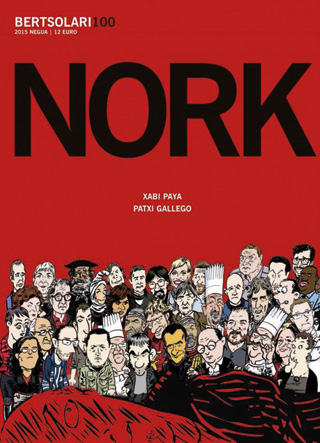

In recent years, Bertsolari magazine has chosen to unite bertsos and comics with the creation of a society. In 89, Patxi Gallego and Xabi Paya began to publish the first pages of the book Nork, titled Hamar bertsolaritxo. They were hooks in number 100 to publish in their entirety.
This work combines different common paths in the comic book: the Ukronia, the detective history and the parody. There is a small Ukronia, as the plot starts at the 2013 Bertsolaris Championship, but to start the game of fiction: Andoni Egaña is the champion in 2013. Even when he is going to be fired, Egaña is killed in the championship. That's where the detectives start to act and also parody them.
The first step of this parody is the profile of the detectives: there is not a single detective, as usual, but a group of detectives: Bertsokop, who flashes in the technological spaces of Bertsolarism; Amaia Ezpeldoi, an errural detective of the novels of Itxaro Borda (depicted in the comic as alter ego of the writer); Jesika Fletxeberria, who remembers the detective of popular culture; and the aguacil of Amezketa, Fernando's cartoon character. As reflected in the election of the detectives, they play with the intertextuality to create humor; along with familiar characters from the world of Bertsolarism have drawn people known in visual culture (politicians, cooks, musicians, presenters…), and at some point comic characters (Gartxot, Ipurbeltz, Punki, Xabritxo, Xabinaitut, Zakilixitut). They've been able to identify the visual culture rooted in the collective imagination, and Patxi Gallego, once again, has shown the ability to imagine faces and bodies.
The contribution of Xabi Paya has been fundamental, both in intercalating verses in the comic book and in parodiing the trends, customs and attitudes of the bertso world. Regarding the theme, power games, authority clashes and the competence of bertsolarism and cultural action predominate. In this regard, some of the concerns that have already been made explicit in Bertsolarism are addressed, inter alia: the genealogies of Bertsolaris, gender conflicts and territorial delegations. In any case, gender conflicts are materialized in concrete bertsolaris (with some sexist representation of corporality), while reflections on territoriality do not materialize in concrete bertsolaris, as they are represented under the cover of the representatives of the countries.
The comic keeps the intertextuality, the narrative tension: on the one hand, in the evolution of the plot, due to the good dosing of information about research (and the good stitching of the secondary plots); on the other hand, to the typographical options, the multiple frames and the rich syntax of the comic, the narrative has perfectly maintained the visual rhythm.
Nork
Xabi Paya, Patxi Gallego
BERTSOLARI
100. zenbakia, 2015